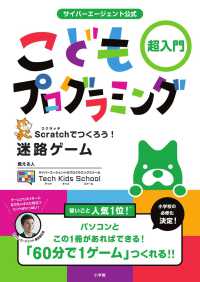Full Description
Curriculum LeadershipFourth Edition is a one-of-a-kind resource written for educational leaders--administrators and teachers--who want to successfully restructure and enhance school curriculum. Authors Allan A. Glatthorn, Floyd Boschee, Bruce M. Whitehead, and Bonni F. Boschee provide innovative and successful curriculum ideas, including reflective case studies, "Keys to Leadership" sections, curriculum tips, and "Challenge" sections with key issues and questions in every chapter. Also interspersed throughout the book are tried and true strategies that provide administrators with innovative ideas on meeting state and national standards. This is a much needed, highly informative, and easy-to-read account of curriculum development and change for curriculum leaders, those teaching curriculum courses, and those aspiring to become curriculum decision makers. It provides the knowledge and skills needed to develop and implement a PK-12 school curriculum. * New coverage of technology includes technological functionalism, the impact on professional development, and the link between technology and student achievement * Additional coverage of globally connected classrooms provides emphasis on contemporary theory and global technology in K[en dash]12 education * New topics on improving schools include how to close the achievement gap, the importance of student outcomes, individualized learning, and innovative developments within differentiated instruction* Expanded coverage of curriculum processes shows educators how to enhance curriculum through examples such as the importance of reinventing schools from a technology enriched global perspective* A comparison of education before standards-based education, during the standards movement, and under the Common Core State Standards* Increased focus on the role of the teacher as curriculum leader demonstrates how aspiring curriculum leaders can become more effective* An emphasis on the mind-set of new 21st century learners discusses elements for integrating technology at a whole new level* Inclusion of the Gray Oral Reading Test provides reading teachers with a coaching lesson plan that includes responsibilities and benefits of valid and reliable skill level assessments* The Elementary and Secondary Education Act (ESEA) revisions are addressed as well as aspects of NCLB compliance and waivers.* Up-to date resources and contemporary case studies help curriculum leaders implement ideas
Contents
Part IChapter 1: The Nature of CurriculumThe Concept of CurriculumThe Types of CurriculumComponents of the CurriculumThe Mastery, the Organic, and the Enrichment CurriculaThe Hidden CurriculumChapter 2: Curriculum HistoryAcademic ScientismProgressive FunctionalismDevelopmental ConformismScholarly StructuralismRomantic RadicalismPrivatistic ConservatismTechnological ConstructionismModern ConservatismTechnological FunctionalismChapter 3: Curriculum TheoryThe Nature and Function of Curriculum TheoryLeadership in Curriculum TheoryClassifying Curriculum Theories Structure-Oriented TheoriesValue-Oriented TheoriesContent-Oriented TheoriesProcess-Oriented TheoriesOrganizational Leadership ModelsResearch Theory into Practical ApplicationCurriculum as ChangeTechnology:Catalyst of ChangeThe Theoretical School of the FutureChapter 4: The Politics of CurriculumMyths about America's SchoolingPolitical, Cultural, and Socio-Economic RealitiesAn Overview of the Curriculum-Influence ProcessThe Role of the Federal GovernmentState Role in Curriculum - State Standards InitiativesThe Role of Professional OrganizationsGuiding Preservice TeachersThe CourtsLocal Educational Leaders - New Role of Principal in CurriculumThe Classroom Teacher - Impact of special education on regular classroomTechnology and Elements of ChangeGlobal ConnectionsPart II: Curriculum ProcessesChapter 5: Curriculum PlanningA Goal-Based Model of Curriculum PlanningDetermine the Locus of PlanningDeveloping a Curriculum FrameworkDetermine the Organizational Structures NeededIdentify and Allocate Leadership FunctionsImportance of IntegrityAligning Educational Goals with Curricular FieldsDeveloping a Curriculum DatabaseDeveloping a Planning CalendarConducting Needs AssessmentOrganize, Evaluate, Change, Provide ResourcesImportance of Professional DevelopmentTechnology-21st Century LearningGlobal Connections: Research & PracticeChapter 6: Improving the Program of StudiesReconceptualizing Programs of Study - Research-based curriculumRestructuring Programs of StudyImproving the Program of StudiesImproving Low Performing SchoolsClosing the Achievement GapOperationalizing Change and ReformAssessing Learner & Cultural NeedsProfessional Development ProtocolsDeveloping Cultural LeadershipGlobal ConnectionsBuilding 21st Century Technology CultureChapter 7: Improving a Field of StudyReconceptualizing Fields of Study - The way we teach curriculum has shiftedThe Role of the Principal in Curriculum DevelopmentImproving the Field of Study - Making connections between various fields of studyA Rationale for a Teacher-Centered Process-Teacher led programsStudent-Center ProcessPreparing to Teach Culturally Diverse ClassroomsMapping the CurriculumAssessing and Selecting MaterialsProfessional Development PrioritiesHuman Development: Importance of Teaching EthicsTechnology-Reconceptualizing 21st Century LearningGlobal ConnectionsChapter 8: Processes for Developing New Courses and UnitsThe Technological Process of Curriculum PlanningThe Naturalistic Process of Curriculum PlanningPreparing Schools for New Beginnings with TechnologyGlobal ConnectionsPart III: Curriculum ManagementChapter 9: Supervising the Curriculum: Teachers and MaterialsCurriculum: Current Approaches Problems and Issues in SupervisionThe Role of the Curriculum SupervisorDifferentiated Professional Development-Teacher trouble shooting guidesMotivating StaffMaslow's Theory of Human NeedsCurrent Motivational TheoriesSupervising the Supported Curriculum-Executive Regional Directors (ERD's)Culturally Relevant TeachingGoing Deeper into Teaching and Learning with TechnologyDigital Solutions to 21st Century LearningGlobal ConnectionsChapter 10: Curriculum Development and ImplementationDeveloping a Program Philosophy and Rationale StatementSample Language Arts English Program RationaleMethods for Choosing Teacher RepresentationThe Committee StructureSamples of Program Scope and Sequence-National Core StandardsIndicators of Effective Curriculum DevelopmentProfessional Development for StakeholdersTwenty-First Century Technology GoalsGlobal Connection: Narrowing the Achievement GapChapter 11: Aligning the CurriculumA Rationale for Curriculum AlignmentRole of the PrincipalCurriculum DesignOrganizing the Alignment ProjectOrganizational StrategiesIdentifying the Mastery ObjectivesDeveloping Curriculum-Based AssessmentsCorrelating the Mastery List and Instructional MaterialsDeveloping Instructional Planning AidsImportance of ResearchDeveloping Reporting MaterialsData Driven ProgramsProviding Professional Development for the Alignment ProjectMonitoring and Evaluating the Alignment ProjectUnderstanding the Importance of CurriculumClassroom Learning and 21st Century TechnologyGlobal ConnectionsChapter 12: Curriculum EvaluationCurriculum Evaluation DefinedEvaluation Models-Instant surveys and data collection through technologyDeveloping an Eclectic ApproachEvaluating a Field of StudyPurpose of Evaluation: Measuring Effectiveness vs Developing TeachersThe Written CurriculumThe Supported CurriculumThe Taught CurriculumThe Tested Curriculum- Administrative monitoring of Student Academic SuccessThe Learned Curriculum -National Core StandardsLeadership and EvaluationMeasuring for SuccessEvaluation Program GuidelinesEvaluation Strategies for SuccessTechnology and Evaluation:The Final Piece to the PuzzleGlobal Connections: Evaluation and AccountabilityPart IV: Current Trends in the CurriculumChapter 13: Current Developments in the Subject FieldsDevelopments in English/Language Arts/Reading/WritingEnglish/Language ArtsReadingExpanding a Culture of WritingDual Immersion Programs in Language ArtsHistory/Social StudiesMathematicsScienceScience, Technology, Engineering and Mathematics (STEM)Foreign LanguageEducation in the ArtsPhysical Education and HealthCommon Core State Standards and Multicultural EducationTechnology and Exponential ChangeGlobal Connections: Teaching Content Across CulturesChapter 14: Current Developments Across the CurriculumImportance of Thinking, Listening and Speaking SkillsEnglish Language Learner Education (ELLs)Leadership for Socially Diverse GroupsAccommodating DiversityInnovation and 21st Century LearningProfessional Development and TechnologyGlobal Connections: Canada's Shifting Minds ModelChapter 15: Individualizing the CurriculumTypes of Individualized ProgramsEnhancing Teaching & LearningSpecial Needs & Cross Cultural Comparisons in EducationAdaptive Programs for the GiftedPre-K and Early Childhood EducationSocial & Economic ConsiderationsDigital Citizens & a New Culture of the 21st CenturyGlobal Connections: Positive Impact of Education Worldwide








